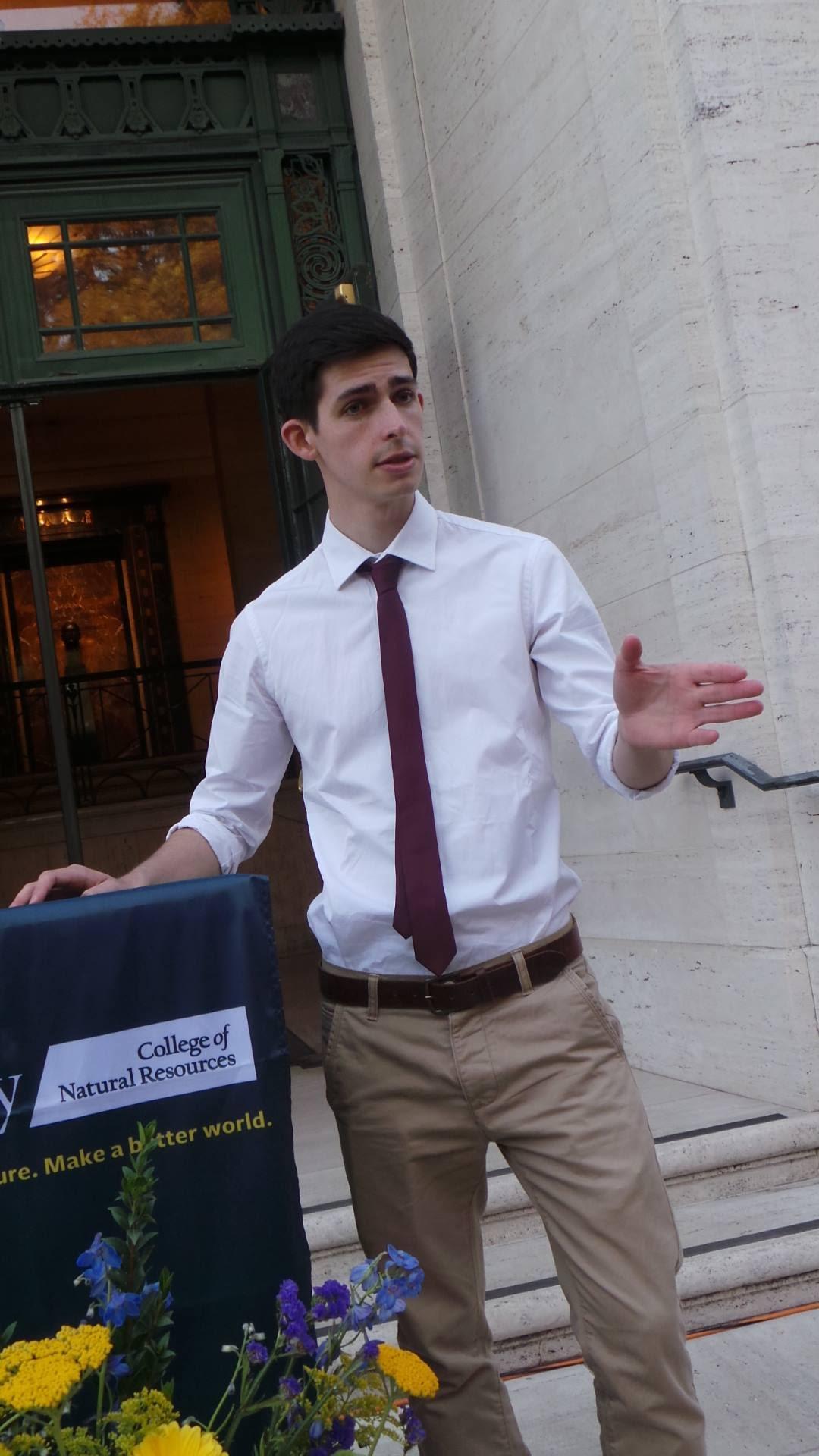by Dan Harris (ELP 2016) | Student, University of Oxford, United Kingdom
What do models of leadership in universities and in the field of academia have to do with tackling climate change? As it turns out, quite a lot.
I have been directly focused on the ethical implications of different approaches to climate change responsibilities for two years and am set to delve ever deeper once I begin my doctoral program in climate justice this September. One key challenge faced by politicians, campaigners and policymakers and myself is how to make sure people comply with their duties of mitigation of, adaptation to and compensation for the effects of climate change. I could discuss the various nuances of approaches towards the distribution of these duties: (causal accounts, beneficiary accounts, capacity accounts and so forth). For now, if you can, accept that what is owed is a relatively settled question, with the bulk of responsibilities falling on developed countries for their historic and on-going contributions to the process of climate change. Accepting the distribution of responsibilities amongst developed and developing nations is only one of many hurdles faced by policymakers, climate scientists and indeed academics (myself included). How do we ensure that those duties policymakers regard as just and fair are complied with? The sorts of answers that describe some sort of cosmopolitan climate duties council are (at least presently), fanciful. I tend to advocate for realistic optimism; that is, given the present political, social and economic conditions as well as the state of scientific knowledge regarding the timescales and predicted effects of climate change, what is it that we can achieve now?
Again for present purposes let us abandon idealistic notions of such a global enforcement body. What can be achieved in their absence? The answer I tend to give draws on Simon Caney’s distinction between first-order and second-order responsibilities. First order responsibilities are those that states possess to actually mitigate/adapt/compensate whereas second-order responsibilities are those possessed by other agents with “duties to induce agents to comply with their first order duties.” Everybody, from journalists to “charismatic individuals,” Caney writes, may all possess these second-order responsibilities precisely because they have the ability to discharge them. These individuals have the capabilities to help ensure that those with first-order responsibilities comply and on that basis they have these second-order responsibilities. As a beloved character from the Marvel universe has stated, with great power comes great responsibility. In simple terms, that I can make a difference means that I should make a difference and I do something morally wrong when I fail to. Climate scientists, climate journalists and, I would add, academics in a variety of fields, have these second-order responsibilities and whilst they have not been silent they could certainly do more.
Climate change is the ultimate collective action problem, and there are key roles to be played by those who don’t have direct duties to mitigate or adapt to the effects of climate change. The role of academics can and has been seen in the work of government committees, most recently for example in the UK Climate Change Risk Assessment 2017. A brief review of the report’s lead contributors reveals academics from no less than 8 UK universities compiled the evidence report on which the Risk Assessment was based. Academics are already starting to carry out their second-order responsibilities. However, in order to carry out these responsibilities effectively they need to make sure they are practicing effective leadership skills. By providing successful leadership within universities and in their interactions with government departments and committees, academics will not only apply pressure to groups and parties with duties to mitigate but also start to inspire behavioral change at the individual level.
What approach to leadership do we find in the world of academia? This question often appears to have been overlooked. Universities are institutions of higher learning and perform a key role in shaping the minds of the next generation of thinkers, leaders, policymakers and scientists, (to name but a few), and yet the style of leadership used in academia is frequently ignored, especially at the departmental level.
Given that the 21st century heralded the supreme success of the ‘information age’, the most productive models for leadership are those that embrace non-hierarchical, open, information-sharing structures. In contrast with traditional leadership models it is arguable that universities were in fact amongst the first to adopt a more collaborative approach, given their dedication (in name at least), to the discovery, dissemination and generally furtherance of knowledge. In comparing and contrasting the 8 Differences Between Traditional and Collaborative Leaders, we see that academia encourages some practices by design but falls short on others.
Traditional leaders draw their power from their position of authority, keeping a tight grasp on information, with limited responsiveness to suggestions from their teams, dictating solutions to problems, allocating resources reactively and creating an isolated work structure. This stops the team from being able to tackle the root causes of problems and fails to provide adequate feedback for the lifting of team morale and development.
In contrast, collaborative approaches to leadership recognize that encouraging participation and openness to ideas from all team members helps to develop the best solutions. Moreover, by sharing time, effort and information equally and providing resources proactively, collaborative leaders are better able to deal with the root causes of issues rather than merely their symptoms.
When it comes to tackling climate change, collaboration is better than control with a capital ‘C’. It is clear that there are many different threads to the problem of climate change; how it will impact food systems and security, migration and the frequency of natural disasters to name but a few. Our response will require leadership that emphasizes participation by individuals, groups, corporations, governments and more. It is only through collaboration amongst scientists, policymakers, researchers and interest groups that we will achieve the best solutions. As a result we need to come out from behind ‘the podium’ and engage openly with different disciplines.
Universities have historically been regarded as institutions for cutting-edge research, with openness to new ideas, sharing information freely in order to answer the ’big questions’ and find solutions to the challenges we face. It is arguable that climate change is the greatest challenge we as a species face in the 21st century. It is therefore crucial that universities play a role in facilitating the tackling of this problem. However, universities frequently face issues concerning the allocation of resources at the institutional and departmental level. In addition bureaucratic disorganization regularly prevents useful synergies between departments working on related issues. With that said in the field of climate change responsibilities I have already begun to witness further shifts that will enhance this collaborative approach.
As Mark Twain penned, write what you know. My example comes from my own (limited), academic ‘career’. I have studied the field of political theory for the past two years and in that time I have witnessed how political theorists focused on climate change (including Henry Shue, Simon Caney and Daniel Butt to name but a few), operate. They are increasingly practicing a collaborative style of leadership. There are various reading groups and public lecture series that operate on a weekly basis, allowing for the refinement and challenging of arguments by those in a variety of different fields. This improves the strength of the ethical arguments involved and often forms the basis of relationships for future collaborative efforts. Another specific example is that of Henry Shue, who is a political theorist based in the department of politics and international relations. He regularly attends meetings of the Crysopheric Scientists at the Environmental Change Institute in order to lend scientific support to his theoretical frameworks, contributing towards more robust, practical policy initiatives. Academics are also often willing to meet with students whether they are their supervisors or even within their discipline. There remain restraints regarding funding for research at the doctoral and postdoctoral levels and the resources which are allocated do sometimes exclude relevant parties because of differential departmental affiliation. In this way universities need to do more to decrease the extent of bureaucratic rules that sometimes prevent academics from forming interdisciplinary partnerships on the basis on funding deficits.
In closing I would like to once again emphasize taking a realistically optimistic approach in proposing solutions to the problems posed by climate change. In the case of political theory as a discipline, a constant challenge is striking the right balance between how we think the world should operate and how it does presently. For political theorists the issue isn’t about getting to the root of the problem. Often what we are best at is examining the underlying moral intuitions and ethical positions within political disagreements. Instead, not enough attention is paid to how these underlying intuitions feed into actual political disagreements with the result that the suggestions made are hopelessly idealistic or rest on too many other presumptions about how the world should operate. Working more closely with climate scientists and those currently making climate policy would likely provide significant benefits to all disciplines and, with any luck, hope for the future.




